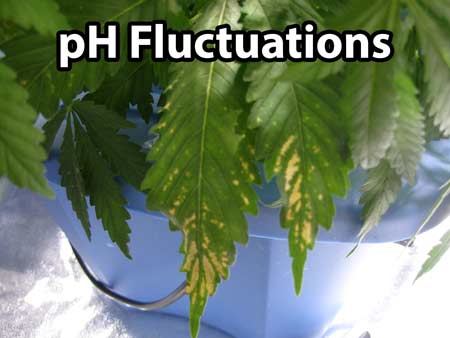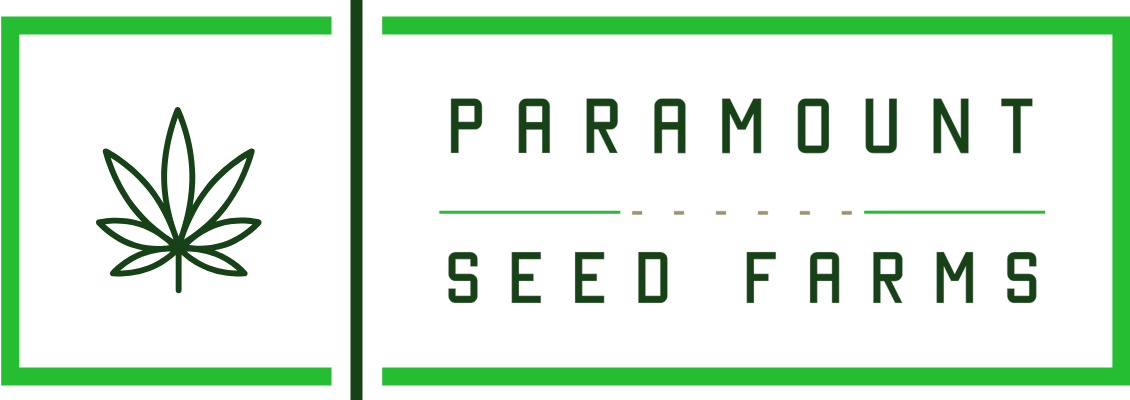Do Your Marijuana Leaves Have Nutrient Burn?
Quick Summary: Nutrient or fertilizer burn is one of the most common beginner cannabis growing problems. Too-high nutrients cause the yellow or brown leaf tips at the roots, which disrupts the flow of water through the plant and causes the symptom of burnt tips on leaves.
(Nutrient burn is often called ‘Nute Burn’ in the cannabis growing community).
When the roots take in more nutrients than a cannabis plant can use, the overabundance causes problems with water flow in the plant, triggering brown or bronze ‘burns’ on the tips of your leaves. If nutrient levels are not lowered, the burnt tips start traveling inwards, and the leaves ends become crispy and twisted.
As nutrient burn progresses, the tips get bronze, crispy, curled, and sometimes twisted. Although you can stop the nutrient burn from worsening, the burnt appearance won’t go away on the already affected leaves.

Nutrient burn is most common when feeding cannabis too-high bottled nutrients, primarily chemical or mineral. This is what you’ll find in most non-organic plant food.
Mineral-based nutrients can help increase cannabis growth rates and yields compared to organic-based nutrients because plant roots absorb these nutrients easily. The plant doesn’t have to do any ‘work’ to get the nutrients. The downside is your plant can easily take in more than it can use if the nutrient levels are too high.
Nutrient burn affects the tips of marijuana leaves. You may see it on one or two leaves, or it can appear all over the plant.

Nutrient burn can also happen when plants or seedlings are grown directly in soil with a high level of nutrients (a ‘hot’ soil or growing medium), such as fresh compost, manure, or a nutrient-amended soil mix. This usually happens to young seedlings, and they will ‘grow out of it as they begin to use up all the nutrients in the soil, as long as more nutrients are not added.
In general, plants use overall higher levels of nutrients as they get more light. Therefore plants in relatively low light conditions can get nutrient burn at lower levels of nutrients than the same plant would under bigger grow lights.
Each cannabis plant is different so you might have just one out of many plants get nutrient burn! That is entirely normal.
Sometimes you’ll also see nutrient-burn leaf tips curl or ‘claw.’ The clawing can be caused by an overabundance of Nitrogen ( Nitrogen Toxicity), typical for plants experiencing nutrient burn from overall high levels of nutrients.

Problem: You will notice the tips of your marijuana leaves showing the first signs of nutrient burn by turning yellow, tan, gold, or brown. A light case of nutrient burn will only affect the tips of your leaves.
The yellow tips will eventually turn rusty brown, and crispy. If you do not correct the problem, you may also notice the burn slowly spreading from the tips to the whole leaf. If you haven’t done so already, you should immediately treat your plant (directions below) before there’s more damage.

Nutrient burn can also manifest as brown or bronze spotting around the edges of the leaf serrations (often when there’s a problem with proper absorption of potassium) or with leaf tips curling downwards (tips pointing down are often associated with too much nitrogen).
Nutrient burn causes tips to start curling up if it gets bad enough
How to fix cannabis nutrient deficiencies
Light Stress can cause yellow tips or edges, which can sometimes be confused with nutrient burn
This is a Potassium Deficiency, not a nutrient burn!

pH Fluctuations
Why Growers Should Try to Prevent Marijuana Nutrient Burn
I have heard some growers say that a little nutrient burn is a good thing because it gives your plant the highest level of nutrients it can use. Many growers mistakenly believe that nutrients are somehow ‘food’ for your cannabis plants, so more food = more energy = bigger yields.
This is wrong. Instead, nutrients are more like a multi-vitamin for your plant. Just like you can’t give a child 10 multivitamins a day to make them grow faster, you can’t give your plants 10x the regular does of nutrients and expect anything good to happen.
The actual ‘food’ for your plant is light. Your plant produces energy from light through a process known as photosynthesis, which is most effective when the plant has healthy green leaves.
Your leaves are like solar panels; the energy produced by the leaves is used for the whole plant. You need the leaves in tip-top shape to get the most energy from the lights so your plant has plenty of energy to grow and produce buds.
Therefore, the biggest problem with nutrient burn is the fact that you are losing leaf mass and overall leaf robustness on your cannabis plant.
A little nute burn won’t slow down your plants much, if at all, but if nute burn is left out of control, you will begin to lose leaf mass, dramatically slowing down plant growth and reducing your overall yields.
What’s worse, if excess nutrients are not flushed out of the plant’s system before harvest, the buds may contain trace amounts of extra nutrients, giving the buds an unpleasant chemical-like taste. Speaking of the flowering stage

Nutrient Burn is More Serious in Flowering Stage
Cannabis plants spend the beginning part of their life in the vegetative stage. When cannabis plants enter the second part of their life, the flowering stage, they stop focusing on making leaves and stems and put all their focus on making buds/flowers.
The flowering stage is the most vulnerable stage for cannabis plants because they cannot bounce back from any problems.
The further you get into the flowering stage (and the closer you get to harvest), the less likely the plant will replace a damaged or dead leaf. When a harvest is around the corner, your plant stops attempting to recover from leaf damage, and its focus is on fattening buds.
That’s why budding cannabis plants need extra care to thrive in the flowering stage, a little bit of nutrient burn will probably be okay, but too much nutrient burn can seriously hurt yields because the plant will not recover. If you are adding nutrients to your water, it can be very easy to burn your plants in the flowering stage (even with nutrient levels it was fine with before) as different strains have different needs throughout budding.

Solution to Cannabis Nutrient Burn (Nute Burn)
If you are using bottled nutrients Most people who get nutrient burn feed their plants extra nutrients in the water. First, make sure you are using a quality set of nutrients specifically designed for cannabis plants. Any nutrient system for plants like tomatoes will also work in a pinch. Also make sure you are feeding nutrients for the proper growth stage for example, all cannabis nutrient systems have you feed different nutrients for the vegetative and flowering stage. If you are feeding the wrong type of nutrients for the stage your plant is in, that is an easy way to give your plants lots of nutrient problems, including nutrient burn.
If you are using the wrong type of nutrients for a plant like cannabis, you will eventually run into nutrient problems, one way or another.
Many nutrient systems provide instructions to feed your plant more nutrients than most plants need. It’s good business for the nutrient companies if you use more nutrients. However, in my experience it’s a good idea to view the feeding charts that come with any nutrient system as the maximum amount of nutrients and start with much lower levels. I start with half the recommended amount and slowly work my way up only if needed.
Hand-watered system If you are growing in a hand-watered system (like in soil or coco coir), flush your system with plain, pH’ed water if you notice the first signs of nutrient burn. (Learn about pH). If you are not adding any extra nutrients to your garden, then you need to wait until the plant uses all the excess nutrients in the soil after the nutes have been used up, the plant will naturally get over the nute burn (old leaves won’t recover, but leaves should no longer be getting new brown or burnt tips).
Hydro system Reduce the overall levels of nutrients in your water reservoir by adding plain pH’ed water to dilute the water. You could also mix up a new set of nutrients (at lower levels) and completely change the water.
Be careful not to make significant changes too fast. It’s better to go relatively slowly in hydro.
In hydro, once you change the water and lower the nutrient levels to an appropriate level, you should immediately notice the nutrient burn stop spreading. Old leaves won’t recover, but you shouldn’t notice any leaves worsening.
If you don’t have a TDS meter to measure the levels of nutrients (and other extra stuff) in your water, I would typically start your plants with a fraction (perhaps 1/2) of the nutrients you were giving them before and then work your way up to higher nutrient levels only if you notice the lower leaves are starting to yellow too quickly ( nitrogen deficiency). Even then, try to move up nutrient levels as slowly as possible. If you lose leaves to a nitrogen deficiency from slightly too-low nutrient levels, you will lose a few of the least important lower leaves. But if you raise nutrient levels to fast and get nutrient burn, all the leaves on the whole plant will be affected and never recover fully.
One of the things that can be frustrating about hydro is that different plants or strains will be okay with different amounts of nutrients. You can be feeding 2 plants the same levels of nutrients, and one might get a nutrient burn while the other is getting a deficiency at the same level. This is because different plants absorb nutrients at different rates.
Plus, plants drink more or less water depending on the temperature and humidity of your grow area, so even if you’re familiar with the nutrient levels of a particular strain, it can be hard to keep track of the exact correct nutrient levels until you get familiar with your setup.
Luckily, there is an excellent tool to make this much more manageable in hydro.
In hydro, it is beneficial to get a TDS meter to help you regulate the amount of nutrients in your water. A TDS meter will tell you how much ‘stuff’ is in the water and whether the levels of nutrients are getting higher or lower each time you check. You can test your reservoir at any time to see if the levels of nutrients are rising, so you’ll be able to stop nutrient burn before it even affects your plants.
Bluelab TDS Meter – Paramount Seed Farms uses it every day!
- Conductivity pen can test and monitor your nutrients (TDS) level to maximize your grow and ensure plants get the balanced feed they need; General uses include growing tent, swimming pool, drinking water, aquarium, fish tank, and brewing
- This hydroponics tester has ATC that provides consistent reading regardless of any fluctuations in temperature; Durable design for repeated uses and fully waterproof and it floats in any solution
Last update on 2024-04-30 / Affiliate links / Images from Amazon Product Advertising API
u003cstrongu003eCould your cannabis also be suffering from Nitrogen Toxicity?u003c/strongu003e
Nitrogen toxicity is common on cannabis plants with a nutrient burn.u003cbru003eAre the ends of leaves curling like a claw or pointing down like talons? If your plant is experiencing ‘the claw’ and not just normal drooping from underwatering or overwatering, you may have nitrogen toxicity(too much nitrogen).

